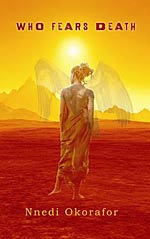
![]() FeminineFantastique
FeminineFantastique
7/13/2014
![]()
Who Fears Death, Nnedi Okorafor's 2010 winner of the World Fantasy Award and the Carl Brandon Society Kindred Award, shares many of the bones of the prototypical epic fantasy novel — the singular birth of the main character and a prophecy concerning her destiny; a quest fraught with danger and mythical creatures; a circle of close companions who choose to share her burden. Only it's set in a future East Africa, includes hand-held computers alongside talking camels, and Onyesonwu is not a reluctant heroine but one filled with rage.
Onye is an Ewu, a child of mixed race conceived during an attempt at ethnic cleansing in an attack so violent that it leaves her mother Najeeba without a voice. Her distraught mother first wishes to die, only to come to fiercely love the baby that she births alone in the middle of the desert. The two wander for six years, for the Ewus' biracial identifiers of sandy hair and skin mark them as children borne of rape and such children are reviled and feared. Finally they settle and Najeeba remarries. In time, Onyesonwu makes her first friends: a mysterious Ewu boy who's also a newcomer to the town, and three girls her age who also elect to partake in the ritual of female circumcision at the same time that she does.
She is only a child when her magical powers appear; they are wild and uncontrolled and she seeks the training of the village sorcerer Aro only to rebuffed because of her gender. Aro only relents when Onye accidentally performs a forbidden bit of magic in public, causing her to be feared to an even greater extent than she had been. She undergoes training to become the greatest sorcerer the world has ever known, and embarks on a journey through the desert to stop the man responsible for so much evil: her father.
Okorafor has been criticized for her depiction of FGM, but I found it a nuanced take. It would have been easy to depict the practice far more brutally or handwave it away; the author does neither. She depicts the coming-of-age ritual as a way that young women form bonds, while it's clear that the practice is unfavorable and driven by fear of female sexuality, one of the major themes of the novel. For the violent and oppressive patriarchy harms the female characters throughout the story not just viscerally but symbolically, in ways that are not bound by any singular cultural practice: Onyesonwu's circumcision leaves her not just incapable of enjoying intercourse, but also stifles her powers; Najeeba's rape leaves her not only traumatized and despondent, but voiceless.
But as much as systemic oppression twists the paths of these characters, it's their courage in the face of it that stands out. Najeeba begins testing her magical gifts at an age far older than typical and uses her newfound powers to make her daughter's path safer. The heroine's friends, kind Binta and brave Luyu, risk their lives for Onyesonwu's safety and her destiny. And Onyesonwu herself, for so much of her life singled out for derision and ridicule, leverages her magic and her bottomless fury to defeat the greatest enemy her nation has ever known.
If I had to choose a single word to summarize this novel, it would be powerful.
http://manicpixiedreamworlds.wordpress.com/